The Economics and Statistics Division maintains archives of previous publications for accountability purposes, but makes no updates to keep these documents current with the latest data revisions from Statistics Canada. As a result, information in older documents may not be accurate. Please exercise caution when referring to older documents. For the latest information and historical data, please contact the individual listed to the right.
<--- Return to Archive
For additional information relating to this article, please contact:
January 03, 2019INTERPROVINCIAL WORKERS 2002-2015 Statistics Canada has recently released revised and updated information on the number of people who report work (T4) earnings in one province while residing in another province.
Over the period from 2002 to 2015, there was an overall rise in the number of interprovincial workers outbound from Nova Scotia to other jurisdictions to 24,775 by 2015 (including returns filed late or subject to adjustment). The number of outbound workers declined over 2014 when it reached a recent peak of 26,680. The number of incoming workers from other provinces working in Nova Scotia was down to 16,305 in 2015.
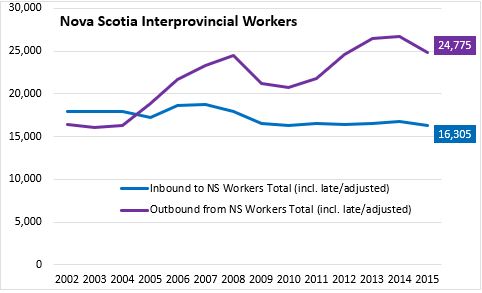
The amounts earned by Nova Scotia workers in other provinces declined to $1.09 billion in 2015, while these workers also reported $0.23 billion earned inside the province. Incoming workers earned $0.4 billion for their work in Nova Scotia and a further $0.24 billion for work outside of Nova Scotia.
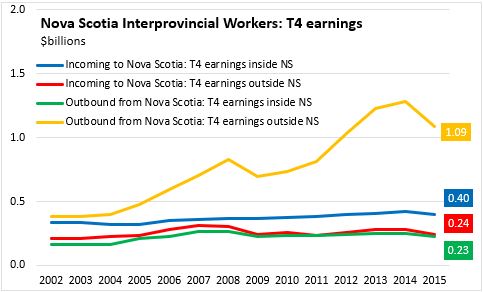
The rise in outbound interprovincial workers from Nova Scotia during 2002-2015 was concentrated in the construction sector, while there were also increases in oil/gas, transportation, other services (administrative/support, waste management, arts/recreation), and professional/technical services. Much of the decline in outbound workers from 2014 was due to a decline in outbound construction workers. Note that these data do not include those who filed late or had adjusted returns.
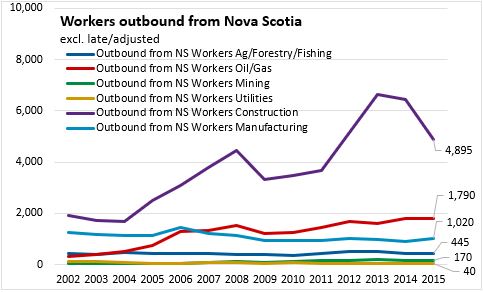
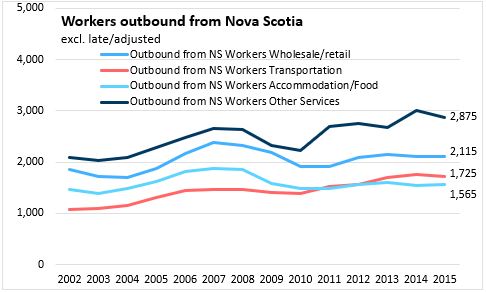
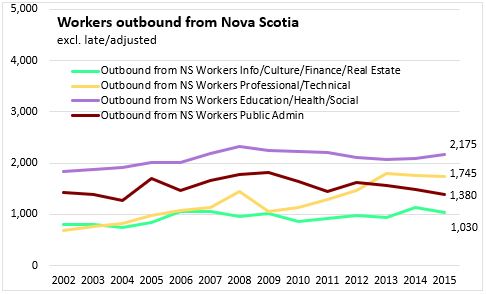
Interprovincial workers coming to Nova Scotia were most concentrated in service work, particularly in health/education/social sectors as well as other series, wholesale/retail, public administration and accommodation/food sectors. Note that in 2015, the increase in inbound workers in the transportation sector is due to a reclassification of firms previously counted in other services.

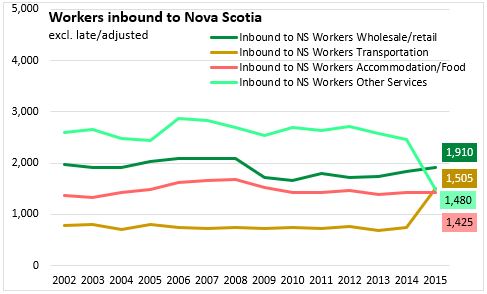
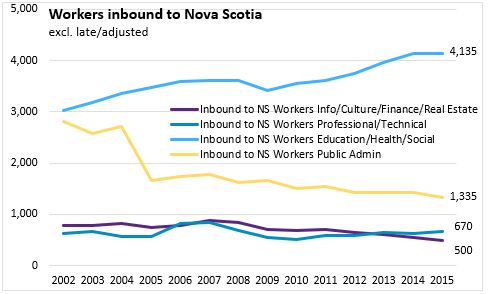
Most outbound workers from Nova Scotia are destined for Alberta, with 8,675 workers outbound in 2015. This represents a decline over 2014 where outbound workers to Alberta totalled 10,905. In 2015 there were increases in Nova Scotia workers bound for all provinces except Saskatchewan, Alberta and British Columbia. Since 2002, Nova Scotia workers bound for Newfoundland and Labrador, Alberta, British Columbia and Saskatchewan have increased while the number of outbound workers to New Brunswick has declined.
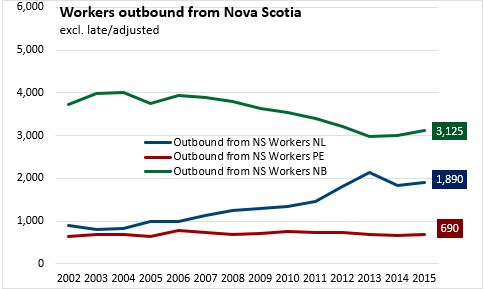

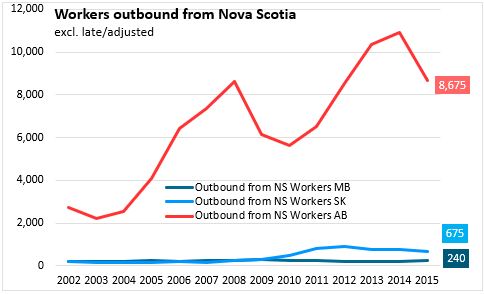
The source of Nova Scotia's inbound interprovincial workers has changed since 2002. There were notably fewer interprovincial workers from Newfoundland and Labrador and New Brunswick working in Nova Scotia while there were more from Ontario and British Columbia, with a somewhat smaller increase in workers from Quebec. Inbound workers from Alberta are also higher than in 2002, although there has been more variation over the period compared to other provinces.
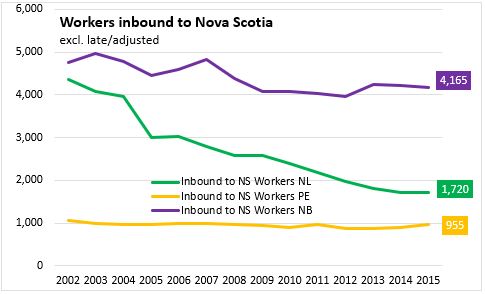
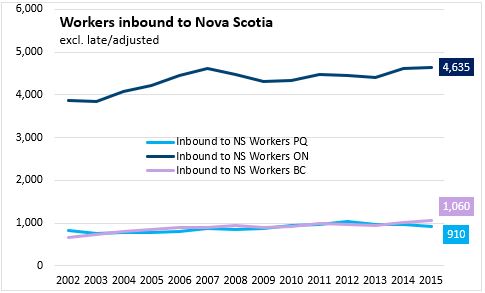
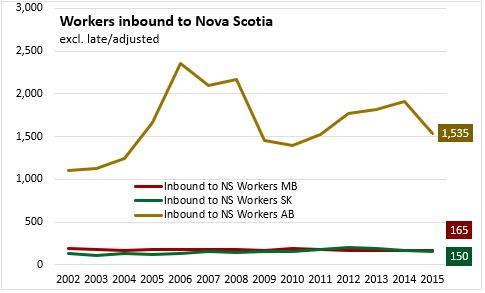
In 2015, the net impact of interprovincial workers (incoming less outbound) amounted to a drain of 2.0 per cent on Nova Scotia's employment. This is measured as a share of resident workers plus those from other provinces working in Nova Scotia, which may not count the number who work in both their home province and another province. Interprovincial workers had been a net gain for Nova Scotia from 2002 to 2004. Compared with the rest of Atlantic Canada, Nova Scotia had a smaller net drain due to interprovincial workers in 2015. Net drain from interprovincial work is not just an Atlantic Canada phenomenon with net drains also reported in Quebec, British Columbia and Manitoba (as well as Saskatchewan from 2002-2011). Alberta had the largest net gain at 3.4 per cent in 2015 while Ontario and Saskatchewan were also positive.

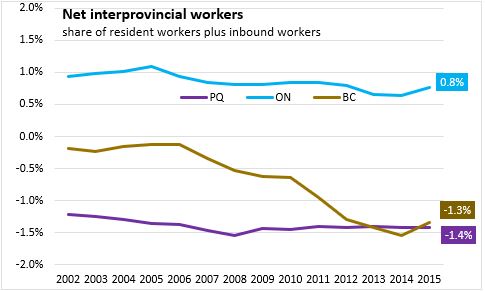
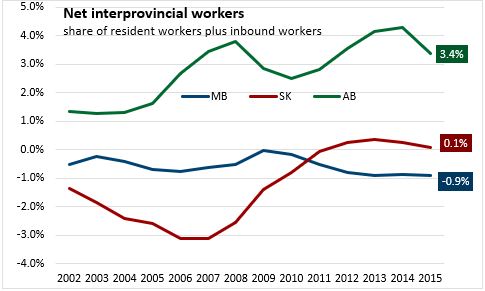
The composition of Nova Scotia's outbound interprovincial workers was disproportionately younger and disproportionately male. Incoming workers to Nova Scotia were also disproportionately younger and male, but to a lesser extent than observed among outbound workers.

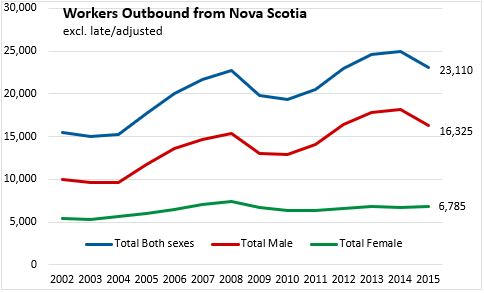
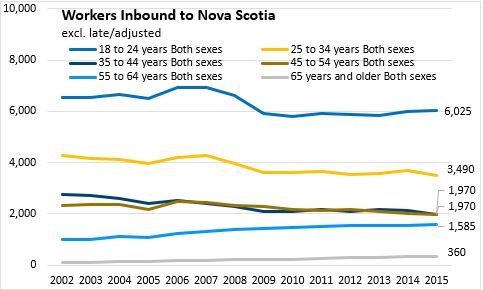
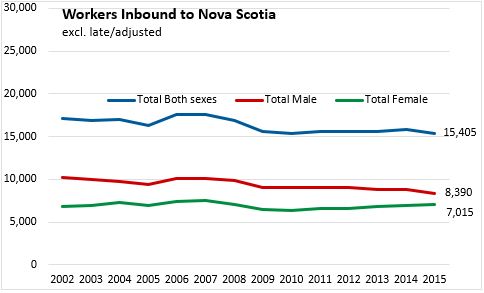
The data presented in this analysis focuses on the period from 2002-2015. This period coincides with a substantial rise in oil prices (USD, West Texas Intermediate) and associated investments in the mining/oil/gas sector - particularly in Alberta. Alberta's investments (real $2012 chained) over this period echoed the fluctuations in oil prices. The need for interprovincial workers to build oil-production facilities also followed this pattern, with an even stronger change in Nova Scotia-resident workers' contributions to the Alberta labour force. Over the subsequent years, oil prices and resource investment in Alberta have declined substantially. The impact that this has on patterns of interprovincial work can be seen in the 2015 data, with a decline in inbound workers to Alberta from the rest of Canada, including Nova Scotia.
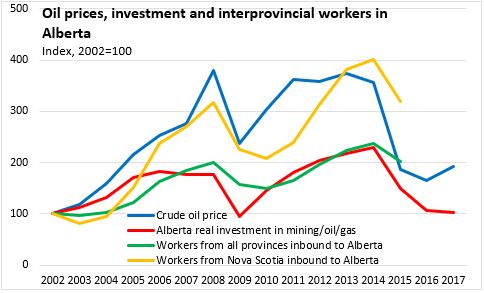
Source: Statistics Canada, Estimates of inter-jurisdictional employment in Canada by province and territory (2002 to 2015), Statistics Canada table 36-10-0096-01; US Department of Energy
<--- Return to Archive